"Sea Wolf" attacks from the depths
Just in the 1970s and 80s, Soviet designers managed to develop several models of military equipment and weapons that surpassed their foreign counterparts. In submarine shipbuilding, such an example was the multipurpose (or, as it is also called, strike) nuclear submarine of project 971 (and the subsequent development of 971U), which in the USSR received the designation "Pike-B", and according to the NATO codification - "Shark" and "Improved Shark "(Or" Shark-2 "), respectively. The last of the boats built under this project K-335 "Cheetah" (part of fleet in 2002), which is the embodiment of the latest technological advances, in the West is called "Shark-3." One of the boats of this project 971, K-152 "Nerpa", on January 23, 2012 was leased to India.
The new Soviet nuclear submarine (technical design of the boat was approved by 30 September 1977 of the year, the lead ship was launched 16 on April 1988 of the year) turned out to be a very successful and complete project. In some ways, he caused a real shock to the American admirals. The submarines of the "shark" family developed a full submerged speed in the 33 node, while possessing very low noise levels and carrying an impressive arsenal of weapons on board. On board the Shark there were four 533-mm and four 650-mm torpedo tubes with a total load of up to 40 units, which was very diverse. 28 ammunition units were in service with the 533 mm caliber, while these torpedo tubes could be used to launch cruise missiles from the Granat complex with a range of up to 3 thousands of kilometers. These missiles could be equipped with both high-explosive and nuclear warheads. In addition, the Shkval high-speed submarine missiles (cruising speed 971 km / h), rocket-torpedoes, and conventional anti-ship, anti-submarine, and universal torpedoes are included in the 375 submarine design armament.
Up until the 1980-s, the Soviet nuclear submarines were inferior to the American ones in such an important indicator as the noise level. Acoustic detection equipment of special anti-submarine aircraft and US naval groups made it possible to track the movements of Soviet submarine forces (though not without difficulty). However, with the creation of the third-generation submarines in the USSR, the Soviet submarines were on par with the Americans in terms of visibility. At the same time, the modernization of second-generation submarines was carried out, which also became much more effective against enemy anti-submarine defense weapons. This was proven by the operations “Aport” (1985 year) and “Atrina” (1987 year), in which the upgraded submarines of the 671РТМ project for several months conducted patrols in the immediate vicinity of the US East Coast, without being detected.
Taking this into account, the US Navy initiated a program to create a special hunter submarine, which should have not only low noise and acoustic visibility, but also sophisticated means of detecting and destroying enemy ships. At the beginning of President Reagan’s reign in the United States, a program called “Fleet of 600 Ships” was launched, the creation of a hunter submarine was one of the points of this program.
"Civulf" - a series of American nuclear multi-purpose submarines of the fourth generation. All boats were built at the shipyards of General Dynamics Electric Boat Corporation from 1989 to 2004 years. Initially, the plans of the US command included the construction of 29 of such submarines, but the program gradually declined, first to 12 submarines, and after the collapse of the Soviet Union, when only the lead ship of the series was in the building, even the project was completely abandoned. As a result, the order was limited to only three submarines. Such a small number of the series was affected by the fact that the problems began already during the construction of the first boat, and the cost of the submarine in prices at the beginning of 1995, reached a huge amount - 2,94 billion dollars. All this, together with a serious change in the geopolitical situation, made the Seawolf boats a piece goods. At the same time, these boats at that time became the most perfect in terms of their characteristics, as well as the most expensive among all previously built.
The main task that confronted American designers was to radically reduce the noise of the submarine. This was achieved through the use of a new type of sound-insulating coating and the use of water jet propulsion, developed in the UK for submarines of the Trafalgar type instead of propeller. In addition, noise sensors were widely used on the boat, they were installed 600 (for comparison: on nuclear submarines such as "Los Angeles" there were only 7 of such sensors). Also, Sea Wolves received the most advanced detection tools at that time.
During the design work of this boat, American engineers for the first time used a high degree of modularity of the structure, which made it possible to obtain a number of characteristics at the output that were significantly higher than the latest hull of the Los Angeles (Advanced Los Angeles) boat. In addition, this approach allowed us to maintain a large potential for future upgrades of submarines and equipping them with promising models of equipment and weapons.
Also, the designers managed to achieve a phenomenal at that time reduction in the noise level of the boat. The “Sea Wolf” hull was completely hidden by a sound-absorbing coating, a jet propulsion unit was installed and various shock absorbers and noise-absorbing coatings located directly inside the submarine hull were widely used. The distance between the mechanisms of the main power plant and the hull of the boat was also increased. Achieving a low level of intrinsic noise guaranteed the boat a silent mode of operation at a submerged speed of up to 20 nodes.
In this case, the hull design was originally developed taking into account swimming and ascent in difficult ice conditions. The nasal horizontal rudders of the submarine, in contrast to the boats "Los Angeles", could get inside the ship. Stern handlebars also turned out different from previous designs. They received 6 stabilizers of the pterygoid form: 4 are arranged according to the standard cruciform pattern (two horizontal and two vertical), and 2 depart at an obtuse angle from the submarine plane of the submarine and are located between the horizontal and lower vertical stabilizers.
The complex of missile-torpedo armament installed on board the boat was diverse and very powerful. It consisted of 8 mm 660 torpedo tubes located on the sides of the boat. This arrangement of TA has become traditional on American submarines and has been used for several decades. This arrangement of the TA allows designers to avoid in the course of the design work restrictions on the location in the bow of the boat of the equipment and antenna of the sonar station.
The total stock of onboard torpedoes and missiles reaches 50 units. Instead of all the rockets and torpedoes on board, the submarine could be loaded up to 100 mines, which are deployed via TA. All ammunition is stored in one compartment, which is located in the nose of the submarine. Submarine ammunition includes: universal torpedoes Mk48 ADCAP (ADvanced CAPability), which are equipped with a powerful warhead weighing 267 kg, passive and active means of target detection. These torpedoes are capable of acting with or without a wire control system. The effective range of destruction of targets in the case of using an active homing system is up to 50 km, and when using passive means it is 38 km. The speed of the torpedoes is 40 and 55 nodes, respectively, and the depth of the course is up to 900 meters. Also, Boeing’s Sub-Harpoon anti-ship missiles (Sub-Harpoon) can be used from the boat, they have a range of 130 km and can carry an 225-kg warhead equipped with an active radar homing head on the target.
Unlike the last Los Angeles-type submarines, the Sivulf submarines did not provide for the deployment of vertical launch installations (CIP) for firing Tomahawk cruise missiles, these missiles are fired from the boat's torpedo tubes. At the same time, the “Sea Wolves” ammunition included both the anti-ship and the strategic version of this missile. The strategic version was equipped with an 200 kt warhead and could cover the distance to 2500 km at subsonic flight speed at a low altitude from 15 to 100 meters above the surface, with the help of the inertial navigation system TAINS (Tercom Aided Inertial Navigation System). At the same time, the circular probable deviation in the nuclear version did not exceed 80 meters. The anti-ship variant of the cruise missile had a combined homing and inertial homing system, and the range was up to 450 km.
All Sea Wolves were distinguished by the presence of an advanced intelligence and countermeasure system on board. The boats had a hydroacoustic reconnaissance and counter station AN / WLY-1, created by Northrop Grumman, an EW AN / WLQ-4 (V) 1, developed by GTE and self-propelled submersible hydroacoustic simulators.
The first boat in the series, dubbed the "Seawolf", was laid in October 1989 and transferred to the 19 fleet in July 1997. Only the 25 of June 2001 of the year was able to enter the boat on its first combat patrol. The first 4 of the year of its operation was accompanied by numerous failures, technical failures, which is natural for the first ship of the new series and the new generation, and emergencies on board. In particular, problems with the jet propulsion system, the CICS, the separate panels of the wide-aperture antenna during the march just came off and lost, and for quite a long time it was not possible to ensure the launch of Tomahawk cruise missiles from the submarine. In August, the head boat 2000, even temporarily removed from the US Navy. The second boat, named Connecticut, was laid in September 1992 of the year and transferred to the fleet in December 1998 of the year.
Delays in financing the work on the third submarine of the series, "Jim Carter", led to the fact that this submarine was decided to build on a new modified project. On this boat, the designers decided to work out new technical solutions, which were later planned to be used to carry out special operations of the SEAL forces, conduct reconnaissance, monitor the tactical situation, detect and determine the coordinates of targets, as well as conduct hidden mines and search for and destroy the enemy’s mines.
To implement everything conceived in the middle part of the submarine's hull (near the center of gravity), a double-hull section with a total length of 30,5 meters was embedded, while the length of the hull of the boat increased to 138 meters. Uninhabited underwater vehicles and other special underwater vehicles were located in the interspace of the sidebars. In addition, a lock chamber with a diameter of about 1,5 meters appeared here, designed to receive and release special forces soldiers and divers. In the submarine’s robust hull, there were accommodations that are designed for finding 50 special forces soldiers, as well as remote controls for unmanned underwater vehicles.
To reach the Jim Carter boat with higher maneuverability while operating at low speeds and in shallow water, an additional steering wheel appeared on it, located in the bow of the submarine. In the course of the work carried out, the displacement of the boat increased to 10 468 tons in the surface position and 12 158 tons in the submerged position. At the same time, in the course of all the work carried out, the noise level of the boat increased slightly, only by 2 dB. At the same time, the cost of building a boat increased to 3,2 billion dollars.
The cross on the program largely set the unexpectedly rapid collapse of the USSR The new US naval strategy now included a shift in core efforts to rivalry in coastal areas. For this reason, the “Sea Wolves”, which were developed to gain dominance in the vast expanses of the World Ocean, did not have a place in the battle formations of the American fleet, especially considering the huge cost of this type of submarines. They were abandoned in favor of Virginia-class submarines, which are better suited for coastal operations and have a lower cost - about 1,8 billion dollars per boat.
Main tactical and technical characteristics of SSN-21 Seawolf:
Overall dimensions: length - 108 m, body width - 12 m.
Surface displacement - 7460 t, underwater - 9137 t.
Immersion depth - 450 m.
Maximum immersion depth - 600 m.
The maximum underwater speed is 35 nodes, “silent” - up to 20 nodes.
The power plant is a nuclear reactor of the type S6W, power 45 000 hp
The autonomy of swimming in stocks reserves - 70 days.
Crew - 116 people, including 15 officers.
Information sources:
http://vpk-news.ru/articles/1487
http://warspot.ru/1015-seawolf-hischnik-na-glubine
http://las-arms.ru/index.php?id=437
http://www.modernarmy.ru/article/121
Open source materials
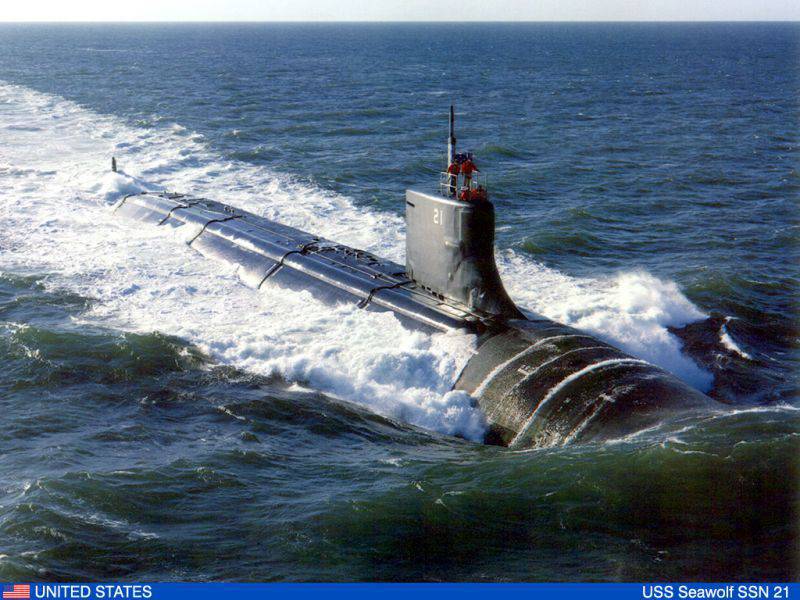
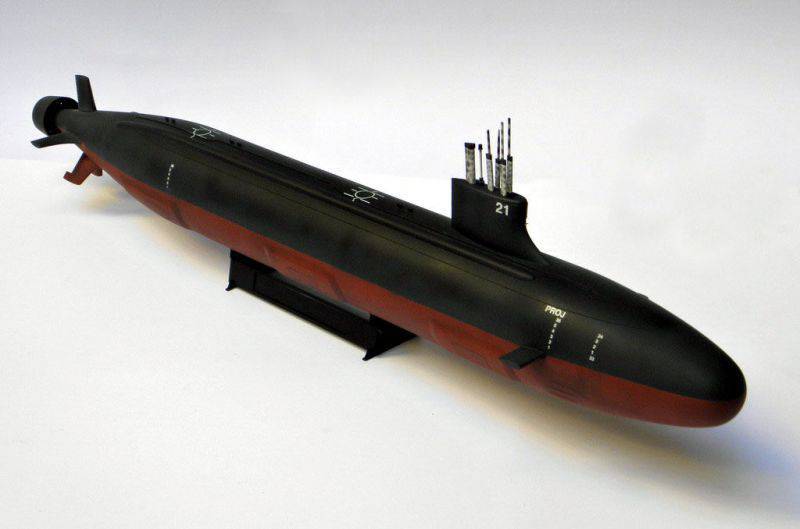
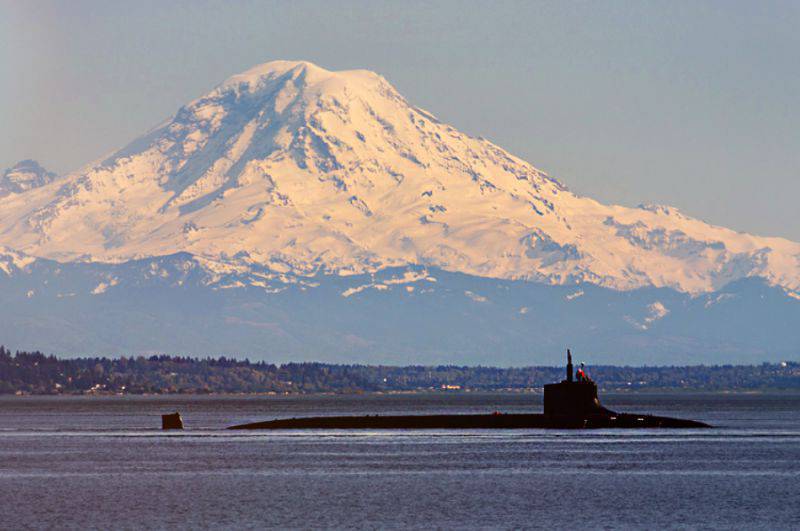
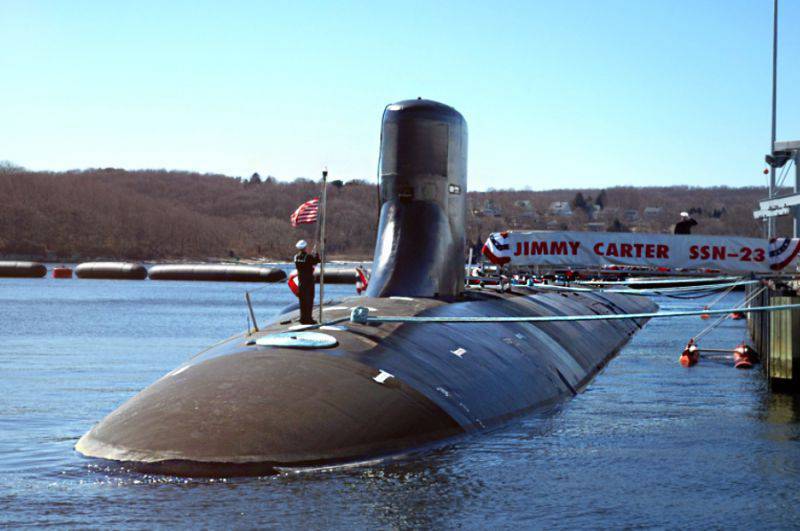
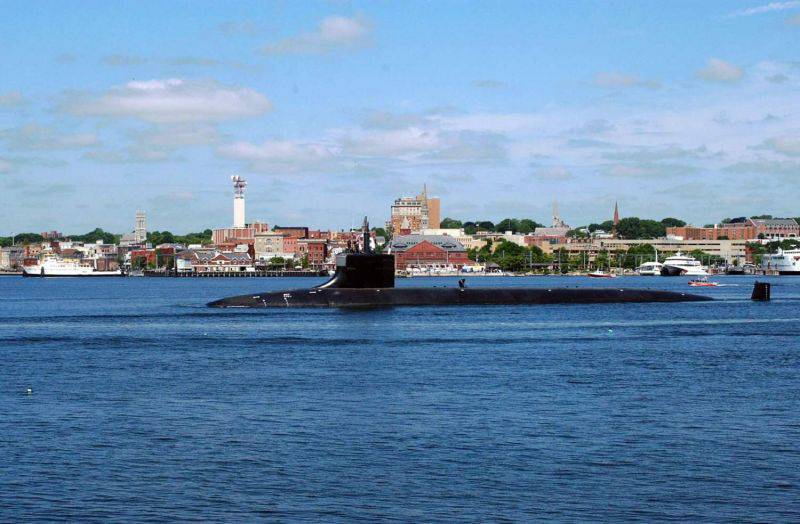
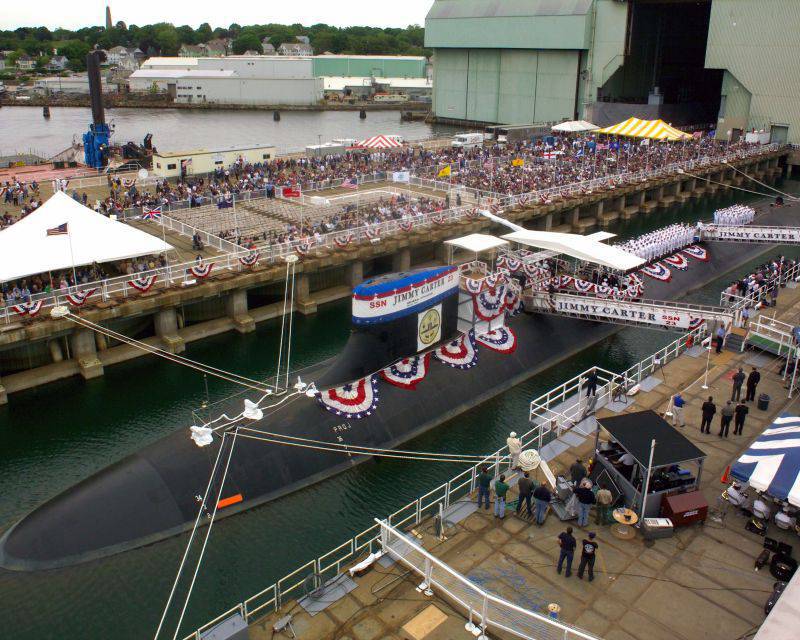
Information